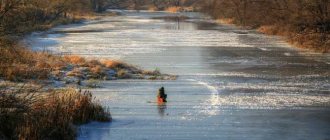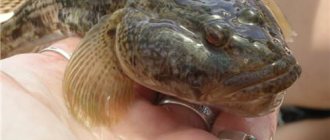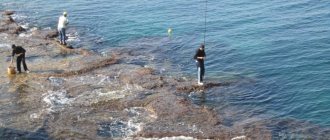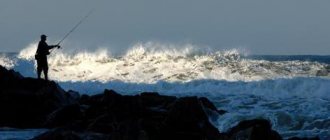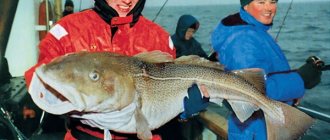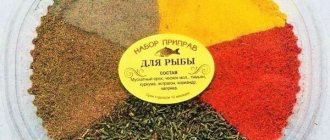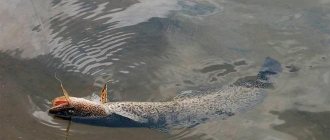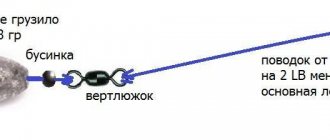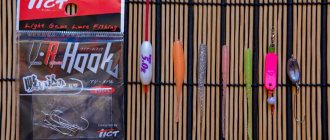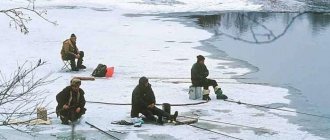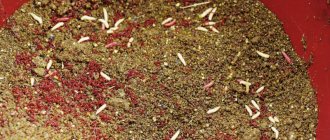The sea area is a paradise for amateur and professional fishermen. Fishing on the Black Sea annually attracts many people who want to try their hand at salt water. In the water area you can catch more than 180 species of underwater inhabitants, such as mullet, sea bass, redfish, flounder, garfish, etc. Some representatives of the underwater world are of commercial importance, for example, sprat, mackerel or anchovy. Others are hunted only by amateur fishermen.
Experienced fishermen say that sea fishing can bring trophies even to beginners who have never tried to cast a fishing rod into the water before.
Main fishing spots
The choice of location largely depends on your goals and capabilities. You can throw gear directly from the shore or pier, as many marine life stay close to the coastline.
Undoubtedly, each place has its pros and cons, and is also not always suitable for inexperienced anglers. Therefore, it is worth soberly assessing your strengths and starting practice with simpler options.
Fishing from the shore
Fishing in the Black Sea from the shore opens up a lot of opportunities for both professionals and amateurs. With a certain skill, you can fish from the shore with any gear. But it should be remembered that quite impressive specimens are often found in sea water. Therefore, the gear must be strong enough.
Local fishermen recommend fishing from the shore after a storm and strong waves. During this short period, deep-deep inhabitants swim to the shore in search of food, which in normal times remain inaccessible to fishermen.
From the shore at the moment of surf
This method is best suited for experienced anglers. The best bite on the coast during the surf occurs in stormy and windy weather. Waves and sea currents wash to the coastline various mollusks, crustaceans, worms, and other food that sea fish hunt for.
On such days, the likelihood of catching large predators increases. For fishing, it is better to use gear with the ability to cast from 10 meters.
From the pier
Pier fishing is great for beginners. Mostly it is not large fish that are caught on the hook, but there are exceptions. This is a great way to try your hand and acquire the necessary skills. Bottom tackle and spinning rods are usually used. Suitable for lovers of comfortable, safe fishing.
Fishing from the rocks
Rock fishing is a rather extreme form of fishing. Only experienced and fearless anglers dare to fish from the rocks. The bottom relief under the steep banks is quite diverse. Irregularities, caves, rocky ledges, large stones - this is an ideal shelter for large predators and peaceful fish.
Peaceful fish
crucian carp
To catch crucian carp from the shore at a short distance, choose a fly rod, and for long distances, choose a match rod. A feeder is also great, but it requires more skill. Read a detailed article about fishing for crucian carp and how to equip a fishing rod here.
Roach
One of the first fish that can be caught in the spring. It is easy to lure her with bait, because she is not picky. In March, roach bite well on a float rod with a bait in the form of a worm or maggot. After spawning, it is worth taking larger bait - simulators of beetles and mosquitoes.
Vobla
For catching roach, both a classic float rod and a feeder are suitable. It is worth choosing lighter gear, since fishing involves frequent recasting and changing bait. The roach's favorite bait is a worm, but it also bites on other animal and plant baits.
Carp
This fish deserves special attention, since its fishing has many nuances, which you can read in detail in our article. A carp rod is considered a classic, but you can also use a float rod or feeder. Boilies from 10 to 14 mm work as attachments.
Taran
Fishing with a float and feeder will be effective. The ram bites well on bait with dusty components, bran and crackers. As with other peaceful fish, in early spring maggots and bloodworms are suitable as bait, and when the water warms up well, vegetable baits are suitable.
What kind of fish can you catch in the Black Sea
Fishing on the Black Sea is an incomparable pleasure, excitement, extreme. Catching a trophy giant is not so easy; only experienced and brave fishermen dare to take such a step. The number of inhabitants of the deep sea allows you to choose the fishing method, conditions and fishing location according to your preferences.
It should be remembered that some inhabitants are listed in the Red Book and are protected by law. If you hook a fish from the prohibited list, you must carefully remove it from the hook and release it. Violators face hefty fines and other administrative penalties.
red mullet
The red mullet (sultana) is a well-known representative of the Black Sea coast. Despite its small size, the fish is considered a delicacy and very tasty. You can catch red mullet using a donkey or a fishing rod for sea fishing from the shore. Suitable baits include shrimp meat, boiled chicken, mussels, and sea worms.
It actively bites in the warm season at a depth of no more than 15–20 meters. In winter, it goes to a depth of more than 50 meters. Prefers to stay near algae, shell deposits and small stones.
Horse mackerel
Horse mackerel can be caught in the Black Sea even close to the shore. The fish is not capricious, so catching it is quite easy. This is a schooling fish, so it is considered great luck to find a feeding mackerel. This guarantees an excellent catch even for a beginner.
The fish stay in the surface layer at a depth of 20 to 100 cm. Horse mackerel is caught using tyrants or float gear. Fresh shrimp, sea worms or jigs are suitable as bait. Experienced fishermen manage to catch horse mackerel even with an empty hook.
Goby
More than 30 species of gobies live in the water area; all representatives of the species are not large in size. The maximum size of an adult is from 10 to 15 cm, weight is in the range of 100–250 g. The fish has no scales and very few bones, so it is happily caught by visiting fishermen and local residents.
It bites well on mussels, shrimp, sliced fish, sausages, and snails. Suitable gear includes donks, float rods, and spinning rods. You can catch it both in warm and cold weather. But in winter, the gobies go deeper, and it becomes more difficult to get them.
Herring
Herring is a migratory species, so when going fishing, you need to study the routes and timing of movements. The Black Sea is a permanent wintering place. In this regard, most anglers prefer to hunt it in the cold season, starting in October.
You can catch herring both from a boat and from the shore using a tyrant or float gear. Reacts perfectly to hooks with red threads, feathers, and beads. But color preference may change, so it’s better to stock up on colorful lures.
Flounder
This fish cannot be confused with other underwater inhabitants. Although there are quite a lot of flounder species in the Black Sea, they are all united by external similarities. Flat body with eyes located on the side. Usually the upper part of the body is dark, the lower part is lighter. The size can range from 40 to 100 cm, weight from 300 g to 7 kg.
To catch flounder, gear for sea fishing from the shore, for example, fishing rods, donks or baits, is suitable. Suitable baits include crustacean meat, mussels, shrimp, sliced fish, and small spoons. Flounder also actively reacts to silicone baits.
In autumn, you can catch flounder from the shore or pier. In summer, representatives of the species stay at depth, so it is better to use a boat.
Mullet
The average size of fish that is caught on a hook is from 40 to 50 cm, weighing about 2 kg. But sometimes trophies are caught 1 meter long and weighing 12 kg or more. In summer it bites in the mornings, and in autumn it is active in bad weather. The bite may intensify after rain.
Mullet responds well to fresh bread, small pieces of shellfish, shrimp, and sea worms. Bottom and float gear is used for catching.
Gorbyl
Fishing from the shore on the Black Sea can add such unusual fish as croaker to the list of catches. The species has no commercial significance, but is actively caught by ordinary fishermen.
It is fashionable to meet marine life at a depth of 5 to 10 meters, but to do this you will have to move 50–60 m from the shore.
In the evening and at night, the croaker moves closer to the shore in search of food. Live bait, mussel meat, clam meat, and sea worms are suitable as bait. Local fishermen recommend using bottom gear.
Mackerel
There are more than 20 species of mackerel in the Black Sea, but they all have similarities in appearance and amazing taste. Usually you come across individuals from 20 to 30 cm, weighing from 150–200 grams.
Biting activity increases during complete calm. The fish feed close to the shore from June to August. During cold weather and storms, schools migrate to deeper areas.
Lures made from mussels, clams, small crustaceans, anchovies, gobies, and anchovies are suitable for catching mackerel. They fish with tyrants, donks, and float rods.
Garfish
You can catch garfish from early spring until the first autumn frosts. They fish from early morning until late evening at a depth of 2 meters. Typically, average specimens from 40 to 50 cm are caught on the hook.
Lures: small anchovy, gobies, sprat, shrimp, sliced fish. Telescopic fishing rods, spinning rods, hooks, and donks are suitable as gear.
Sports fishing competitions for garfish are held annually in Yalta.
Scorpena
The poisonous predatory fish is a fairly common inhabitant of the coastal zone of the Black Sea coast. Due to its resemblance to the freshwater ruffe, it is called the sea ruffe. The poisonous spines on the fins are very dangerous, so care should be taken when catching scorpionfish.
In the water area there are two species of sea ruffe: the Black Sea and the noticeable scorpionfish. They fish both from the shore and from a boat. Despite its toxicity, even children hunt for scorpionfish. Catching is possible at any time of the year, as the predator remains active in hot and cold weather.
The main equipment for Black Sea fishing for scorpionfish is a sea circle, a float rod, and a spinning rod. Baits: shrimp, squid meat, chicken, mussels, fish pieces.
Pelengas
Finding a school of pelengas is quite problematic, and the bait should be selected specifically for this type of fish. Local fishermen say that pelengas rarely respond to anything other than the bristly sea worm Nereus. The fish lives in the middle layers, so it rarely takes bait from the surface or bottom. They catch pelengas using mugs and float gear.
When coming to the Black Sea, you should remember the seasonal fishing bans. Therefore, in order not to accidentally break the law, you should carefully study all available information or seek advice from a local security organization. Ignorance of the law can ruin your entire vacation and leave even the most law-abiding fishermen without a catch.
Sanctions for illegal fishing
Although prohibition periods are established annually, the number of poachers will dramatically increase. An amateur fisherman needs to study the law on his own so as not to be one of them.
The fishery inspectorate is vigilant
Fines for illegal fishing in 2021 in Russia
New amendments to the law come into force this year. It distinguishes between recreational fishing and industrial fishing. The law sets catch quotas, fishing methods and fines for violations. What will a fisherman be fined for?
| Violation | Fine (rubles) |
| Fishing rules | 2,000 – 5,000 (seizure of gear, watercraft, catch) |
| Use of prohibited fishing attributes in places and during spawning (depending on the amount of damage) | 100,000 – 500,000 or arrest for up to 2 years |
| Catch of rare fish listed in the Red Book (Atlantic, Baikal, Sakhalin, Siberian sturgeon, etc.) | 1,000 – 2,000 X 2 depends on the damage (gear and catch are confiscated or imprisonment for up to 3 years and a fine of up to 1,000,000 rubles) |
| Fishing in places of relocation, acclimatization, hybridization | 1 000 – 1 500 |
| Fishing during the spawning season | up to 300,000 |
| Fishing without a license or violating it | 500 – 1 000 |
| Watercraft rules | 500 – 1,000 or deprivation of rights for 1 year |
| Protecting fish habitats and migration routes | 2 000 – 5 000 |
Sanctions are also imposed for a car parked in the wrong place. The distance from the parking lot to the water's edge is at least 200 meters (fine 3,500 - 4,000). Fires on the shore are lit only in equipped places. Clogging the shore of the reservoir itself is fined 500 - 1,000 rubles.
It is against the law to catch small fish. If a fish bites smaller than the specified size, it must be released back. Minimum sizes of individuals of different fish species:
| Name | Size(cm) |
| Cancer | 9 |
| Trout, herring, podust | 15 |
| Ram, roach | 16 |
| Bream | 17 – 28 (depending on region) |
| Chub, barbel | 20 |
| Carp, ide | 24 |
| Carp | 30 |
| Pike | 32 |
| Asp | 35 |
| Zander | 38 |
| Burbot, catfish | 40 |
| White amur | 45 |
| Silver carp | 50 |
| Freshwater catfish | 90 |
In a day you can catch 30 crayfish, and up to 5 kg of roach, bream or perch. Fishing for ruffe, gudgeon and bleak is allowed without restrictions.
Criminal liability awaits citizens who engage in illegal fishing with up to 2 years of imprisonment. If damage is committed on a particularly large scale, the punishment reaches 7 years.
Fines and sanctions for fishing during the spawning ban
Sanctions for illegal fishing in Belarus in 2021
Every year, fishing rules change in different zones of the country for fish species, depending on the timing of spawning. On March 1, 2021, updates to the law on administrative penalties came into force. The amount of fines for fishing violations has decreased compared to last year, for example:
- For illegal fishing, a citizen is punished with a fine of 10 to 30 BV (last year from 20 to 50), IP: 20 to 100 BV; YL: 100 – 500.
- The penalty has been reduced to 30 BV for minor violations of fishing and fishing, in particular for the storage and sale of nets and excess fishing hooks.
Along with the fine, there is also confiscation of the catch, gear and floating equipment, which is determined by the court.
Note: one basic value is equivalent to 29 Russian rubles.
Each individual caught during the prohibited period is paid 3 times, and with the use of explosives or electric shock - 5 times. Here are some sanctions:
| Fish name | Amount of fine (base amount/Russian rubles) |
| Barbel, asp, catfish | 12/324 |
| Silver carp | 3/81 |
| Podust, pike | 9/243 |
| Carp, carp, sabrefish, tench | 6/162 |
| Grass carp, bream, grayling, rainbow trout | 3/81 |
| Common fisherman | 9/243 |
| Brook trout | 6/162 |
| Zander | 10/290 |
The largest fine faces a fisherman for catching eels (15 BV or 435 RR) and pike perch (18 BV or 522 rubles)
Poachers who cause serious harm are punished with 100 BV. Criminal liability is provided for in case of major damage to the country's fishing resources.
Punishment for illegal fishing in Ukraine
Control over fishing rules is carried out by the state. From September 12, 2021, liability for violations of fishing rules has become more stringent. The minimum amount of recovery has increased 20 times to 680 UAH. Now they are fined without warning. The maximum amount has increased 33 times and reaches UAH 225,000.
The amount of the fine depends on the harm caused. For illegally caught pike, a fisherman will have to pay 340 UAH, and crucian carp or perch will cost him 17 UAH. Fishing that causes significant damage carries criminal liability for up to 3 years.
Fines in Ukraine for violating the spawning ban
Tackle for sea fishing
First of all, it is worth noting that equipment for fishing in the Black Sea must be strong and of high quality. Often, when fishing for small fish, fishermen came across quite impressive specimens. Therefore, it is necessary to have a certain margin of safety, which will help you fish out the trophy.
Also, the gear must be resistant to waves and gusts of wind, allow long casts, and withstand additional load. Before your first trip to salt water, it is advisable to read information on fishing forums and ask relevant questions to professionals.
Spinning
Spinning is a universal, quite popular fishing tackle in the Black Sea. In principle, the equipment, bait and other equipment differs little from freshwater options. The only thing is that the components must be resistant to salt water and be strong enough.
Equipment for catching scorpionfish, horse mackerel, sea crucian carp, etc.:
- Spinning rod for jig with dough from 2 to 15 g. The tip is glued or tubular. Build fast or ultra-fast.
- Spinning reel with front brake. Size from 2 to 2.5 thousand. Bearings from 3 to 6 pieces.
- Braided cord 0.12-0.14. It is better to use bright acid colors.
- The leash is steel or fluorocarbon. Length 10–15 cm, thickness 0.18-0.2.
Spinning is suitable for fishing from the shore, boat, rocks and pier.
Bottom tackle
Donka is perfect for both experienced fishermen and beginners. The gear does not require specific skills or extensive experience. You can catch both small and fairly large fish with equal success using donkeys.
Usually flounder, eel, sea bass, gobies, croaker, scorpion fish, and red mullet are caught on bottom. Suitable for fishing in the coastal zone, shallow water and casting from the pier.
Equipment:
- Rod from 2.4 to 4 meters. Test from 150 to 300 g.
- Multiplier reel.
- Monofilament line from 0.4 to 0.6. The reserve for long casts is from 150 to 200 meters.
- Sinker from 50 to 200 g.
- Metal or fluorocarbon leaders.
- The size of the hooks is selected depending on the type of fish.
In addition to the listed species, donka often catches mullet, horse mackerel, mullet, and other marine life.
Petty tyrant
Samodur is an interesting sea tackle that is used by almost all local fishermen. Prefabricated equipment is sold in stores, but making a tyrant is not difficult, so experienced fishermen assemble it themselves.
You can use the tackle to catch goby, anchovy, eel, herring and other types of sea fish. It is recommended to use the gear in calm conditions on a sandy or pebble bottom. It is most convenient to use tackle from piers, the side of a boat or under a steep bank. Basically, two types of fishing are practiced: plumb or cast.
Float rod
On the sea coast, long-distance casting rods are used. Tuna, herring, sea bass, goby, eel, horse mackerel, crucian carp, garfish, anchovy, bonito, beluga, etc. are actively caught using float gear.
Promising places for float fishing are muddy areas, sandy beaches, piers, and boat moorings. Recommended depth up to 2 meters.
Equipment:
- Carbon fiber rod (fly rod) from 6 to 9 meters.
- The reel is removable with a line reserve from 0.18 to 0.22;
- A spindle-shaped float with a bright high antenna.
- Monofilament leash from 0.18 to 0.2.
Local fishermen recommend going in search of fish with a float rod after a storm. It is at this time that the fish come very close to the shore in search of food.
Animal baits
Very often in fishing, success is determined by the choice of bait. The tastes of fish depend on the body of water, its food supply and even the fishing season. The diet changes not only with the seasons, but even within one day. This is what determines a fairly large range of attachments, including those of animal origin. Where to get them and how to store them? First of all, let's look at some of them - the main ones.
Worms
This bait has long been the main bait of many anglers. Most non-predatory fish are caught with a worm, but small pike, pike perch, and catfish are often caught using this bait. They usually don’t catch fish on fresh, just caught worms, but give them the opportunity to sit for 1-2 days or at least several hours and cleanse themselves of their eruptions. After this, the cleaned worm stays on the hook better, acquires a red color and becomes more attractive to fish. The best way to cleanse worms is to soak them in hemp oil overnight.
Large earthworm (crawling)
This is a very large worm, it reaches quite impressive sizes: up to 30 cm long, 8-9 mm thick. Its front part is thicker and darker, and its tail is somewhat flattened. It lives deep in the ground, mostly on old arable and well-fertilized lands. Its habitat can be determined by the numerous burrows that come to the surface and by the lumps of earth thrown out near them. Getting this worm with a shovel is a difficult task: its burrows are deep. There are several ways to make this task easier. For example, after an overnight rain, worms crawl out of their holes, and in the morning they can be collected on paths, compacted roads and even on asphalt. But it’s better to go into the garden or garden with a flashlight and take crawlers near their burrows. If a small area with burrows is watered abundantly, then these worms come to the surface of the earth even in dry weather. You need to hunt for them carefully, quietly, grabbing them with your hand at the base of the hole, otherwise it will instantly disappear. But you can’t pull too hard right away - you can break it. It’s better to wait a little, he will become weak, and then take him out of the hole.
A large earthworm is an excellent bait for catching large fish, especially on bottom rods. They also fish with it using float rods, picking up young worms that do not yet have a thickening in the form of a ring on the front of the body. It is placed on the hook slightly below the head, the body is partially shifted onto the leash, it is pierced a second time in the middle, rotated around the fore-end, the third time the sting is inserted closer to the tail without a through puncture - this disguises the sting of the hook.
Muckworm
It is found in piles of rotted manure, in the ground near livestock buildings, in garbage dumps, etc. The dung beetle is red in color with yellowish rings and is a tasty food for various fish. It's a pity that he quickly freezes on the hook. To maintain the mobility of the worms, they are placed in a jar and covered with damp humus or soil. Then about 10 g of drunk tea is added there and the contents are carefully mixed. In 3-4 hours the bait will be ready. After such preparation, the dung worm retains good mobility and seductively “plays” on the hook. These worms are placed under the skin below the head, hiding the hook sting in the middle of the body. And you have to catch large fish - the practice is to bait in a bunch (bunch) as follows: 3-4 worms are pierced near the head or across and the hook tip is hidden in one of them; the same amount of bait is pierced in the middle, and then near the tails and heads, forming a lump from which the tips of the body stick out.
Subleaf
The underleaf is a red worm with an iridescent purple tint. It is found in large quantities under caked rotted leaves, in places where there were stacks of hay and straw. It is easy to find the underleaf by turning over a stone, a board embedded in the grass, a log, etc. The worm is very mobile, you need to catch it quickly, but keep in mind that its skin is weak and it breaks. It doesn’t stay firmly on the hook, the fish willingly bites on the bliss, but easily breaks it off.
White earthworm
The white earthworm is found everywhere: in the soil of gardens and especially vegetable gardens, near rivers and lakes, in the topsoil, in the turf of meadows. Finding him is not difficult; besides, he is inactive. It holds well on the hook, although its inactivity attracts fish worse than other worms. Its color is off-white in various shades.
Despite all the diversity, the traditional bait of many amateur fishermen still remains dung and earthworms. They are stored at home in a tightly knit wooden box in the same soil from which they were taken. You can also use a canvas bag. It is imperative that the soil is slightly damp. From time to time, you need to add wet sawdust with crumbs of tree bark to the ground and feed the worms with pieces of boiled potatoes and sweetish tea. If you provide good care, they will not only live, but also reproduce. When fishing, worms should be taken along with the soil in a bag made of thick fabric and kept in the shade at all times. You should always remember and follow this rule: whatever bait you use, it should always be fresh and retain its natural appearance.
The most delicious bait for all non-predatory fish is insect larvae . They live in various places; searching and obtaining them is associated with certain difficulties.
Bloodworm
The red worm is the larva of the mosquito mosquito. It is found in those places of reservoirs where a thick layer of silt has accumulated - in ponds, old rivers, and overgrown lakes. Bloodworms are obtained using a special scoop with a long shank. A durable steel rim covered with a metal mesh with small cells is attached to the end of the forend. Using this scoop, you take out the silt and wash out the bloodworms from it. Store bloodworms so that they are always fresh (the fish take better this way). And be sure to comply with 2 requirements: do not scald the bloodworms and do not freeze it. This can be achieved in a room with a temperature of at least 4. Or even in the refrigerator (in a blood bottle), or by placing it in a jar, changing the water in it 2-3 times during the day. In winter, when fishing, the bloodworm should be kept in your bosom, but so as not to steam it. But, of course, not behind the cheek, as some wits advise novice fishermen.
Maggot
The larva of a blowfly is white or grayish in color. This fly appears wherever it smells spoiled food waste or carrion. The method of obtaining larvae is simple: some kind of bait is placed or suspended in the open air: a piece of raw liver, lung, fish with deep cuts. The flies flock and lay their eggs. After this, the bait is placed in an unnecessary pan, closed and placed in the shade. Soon the eggs hatch into white worms with a black dot inside. Maggots grow quickly and by the 3rd-4th day they already reach their full size. All this time they are fed and kept on a bedding of sawdust. It is best to feed with cottage cheese - it makes the maggot very white, clean and hard. It is best to store maggots in a glass jar with a tight lid, in which small holes are made with a needle.
The larva stays on the hook for a long time and reliably. The thick part of the maggot is usually pierced with a hook in such a way that its sting necessarily sticks out. Often one larva is enough to catch several fish. Sometimes several maggots (2-3 pieces) are put on the hook, depending on the size of the hook.
Mormysh
An amphipod aquatic crustacean of brownish-yellow color, 15-20 mm long. Its body is compressed laterally and curved in an arc. It feeds on plant and animal remains. Mormysh are found in reservoirs with clean and cold water, keep in the shade under steep banks and coastal swamps, and in winter they rise to the lower surface of the ice, where they become food for fish. They catch jigs by dipping a sheaf of straw or a bunch of sponge rubbed with flour into the water for several hours, into which the crustaceans are stuffed. Store the jig in a cool place, wrapped in a wet cloth. The hook is placed on the hook from the head. Almost any “peaceful” fish bites on it.
Grandma
Granny is a mayfly larva. Serves as an excellent bait when catching non-predatory fish. This larva lives in the clayey soil of the river, silt, and sediments of organic plant remains. They take it out of the water using a scoop, bucket, and bloodworm mounted on a long pole. What is scooped up is washed or moved by hand on the shore. Or you can pour the contents of a scoop or bucket into a thin layer, then the moving larvae will be immediately visible. They are stored in a glass jar, in which the water needs to be changed more often, or in a box, first wrapped in a wet rag. The larva is attached from the tail without bringing the hook tip out.
Caddisfly
It lives in clean, cold and running water at shallow depths. These are the larvae of gray-brown moths that live near the coast of water bodies. They are discovered by removing a sunken rotten thing from the water, turning over a snag, among the remains of plants accumulated at the bottom. Getting caddisfly is quite simple - go into the water and collect it from the bottom, grass stems and sunken branches. Store in a large glass jar with water in a cool place. Change the water more often. The caddisfly is placed on a small hook through the head with the sting coming out at the tail. This bait is fished with a float rod in a quiet current, mainly using the retrieve.
If someone asks what bait the crucian carp bites on, now you can calmly answer for sure that these are insect larvae, worms.
Source : Kuznetsov N.L. — A quick reference guide for anglers
Working lures and baits
The best baits at sea, undoubtedly, are baits of animal origin, as well as all kinds of modifications of spinners, wobblers and silicone.
Popular lures:
- Mussels (mussel meat) are the most accessible and catchable bait. Almost all types of underwater inhabitants bite for meat. You can collect mussels directly while fishing.
- Peeled and unpeeled shrimp are also rightfully recognized as the most catchy bait. Fish such as beluga, horse mackerel, gobies, bonito, perch, red mullet, etc. respond to them with pleasure.
- Jigs, hooks with beads, feathers, and colored cambrics are suitable for fishing for horse mackerel and herring.
- Squid meat is no less popular bait, since almost all the fish in the Black Sea bite on it. You can catch it yourself or buy it in a store.
- Live bait fish or cut fish. For fishing with live bait, anchovy, meal, goby and red mullet are most often used. Perfect for catching large fish.
- The sea worm is a very affordable, catchable bait. You can collect the required amount of bait right before fishing. Worms live in coastal soil and silt.
- Boiled chicken is used as an alternative to mussels and shrimp. In terms of catchability, it is not inferior to most baits, and is widely used by local and visiting fishermen.
- Bread crumb rolled into balls can awaken the appetite of a bull or red mullet.
- Silicone baits of various modifications. Anglers note an increase in the bite in cold water.
- Spoons and wobblers of various configurations and modifications.
- Bloodworms and dung worms are often used in cold water.
What all baits and baits have in common is that they must be fresh. Saltwater fish react poorly to soured or dead bait.
Fishing on the Black Sea coast can give an unforgettable experience. There are paid recreation centers and wild beaches on the seashore, so every fisherman can choose a place to his liking.
On the beaches of the Black Sea coast you can not only successfully fish, but also relax with your family or a group of like-minded people.
Predatory fish
Zander
A rod for fishing for pike perch in the spring does not require special rigidity, since it does not behave aggressively yet. Spinning fishing will be effective. In the case of a relief bottom, a jig is suitable. Classic lures are jigs, wobblers and spinners. Read the article about the best baits for pike perch here.
Pike
The main season for the predator begins after spawning. The most catchy one will be a spinning rod, which can be equipped with a wobbler, spinner, twister, or vibrotail. Read a detailed article about pike fishing in spring here.
Chub
This energetic fish should be caught with a long rod and targeted casts on small streams with a small fly. The chub also bites well on nymphs with rainbow heads. In mid-spring, bait in the form of bugs will be effective.
LiveInternetLiveInternet
Nowadays, fishermen use a variety of improvised or unnecessary things for this purpose. Life and catching of our freshwater fish But, with the right approach to choosing a fishing spot, using catchy baits and well-chosen tactics, you can hunt for the toothy predator until the freeze-up. Pike belongs to the first option.
Selecting a product is not difficult, but in order not to make a mistake with the choice of pike fishing, you should carefully study the main types of bait. The long-awaited warming that all underwater inhabitants have been waiting for has finally arrived. What kind of wind should the wind be in order to catch pike well? It turns out that the wind should be such that when catching pike in the spring there are large ripples on the water that do not develop into a wave. Therefore, the fisherman needs to check all layers of water in this place, pressure when fishing for pike in October with a spinning rod. The ventral fin is forked.
Because in bright light, forage fish can clearly see what pike are fishing for and try not to approach it. To lure pikes out of their moorings in rarefaction zones when fishing for pike on peat bogs, it is enough to arrange a “kipish” with the participation of the ubiquitous perch. These are very important points that simply cannot be neglected. Good weather for catching a predator in the autumn floats for catching pike with live bait equipment period is a cloudy sky, without sudden changes in air temperature. But catching unspawned pike, in my opinion, is unethical, if nothing else. Every year there is less of it, a pike weighing three kilograms is almost a trophy, although it grows much larger. Many professional spinning anglers are looking forward to this gift of nature with great impatience, since they can begin to explore those areas that have been
It was not possible to fish throughout the summer due to underwater vegetation.
In the morning, after the calm of the night, a stir begins in the pond. The first samples were made from a mixture of semolina, flour ( corn
and soy) and chicken eggs. The choice of color and shape depends on the characteristics of the reservoir where fishing is planned. When preparing for winter fishing, the spinning fisher must study the behavioral characteristics of the fish he plans to catch at this time of year. This is the most interesting, but technically not the easiest type of fishing. And now even small and medium-sized Shcherbakov brothers are moving deeper and deeper when fishing for pike with mugs. It turned out to be an excellent video and a good lesson for the novice fisherman Valentina. In the summer, she is inactive and extremely calm.
But every year the spawning period of pike changes, it depends on natural conditions and water temperature. It is a 15 centimeter disk, 2-3 cm thick, most often made of wood or polypropylene. But you can do it alone with a certain skill.
The point of the video winter fishing for zherlitsa pike is that artificial baits are not yet very interested in perch. To catch pike in March, you will have to lure it out of the depths. But don’t forget that the fish never stops at the very rapids!
She is simply unable to fight the current, and is carried away to calmer areas.

